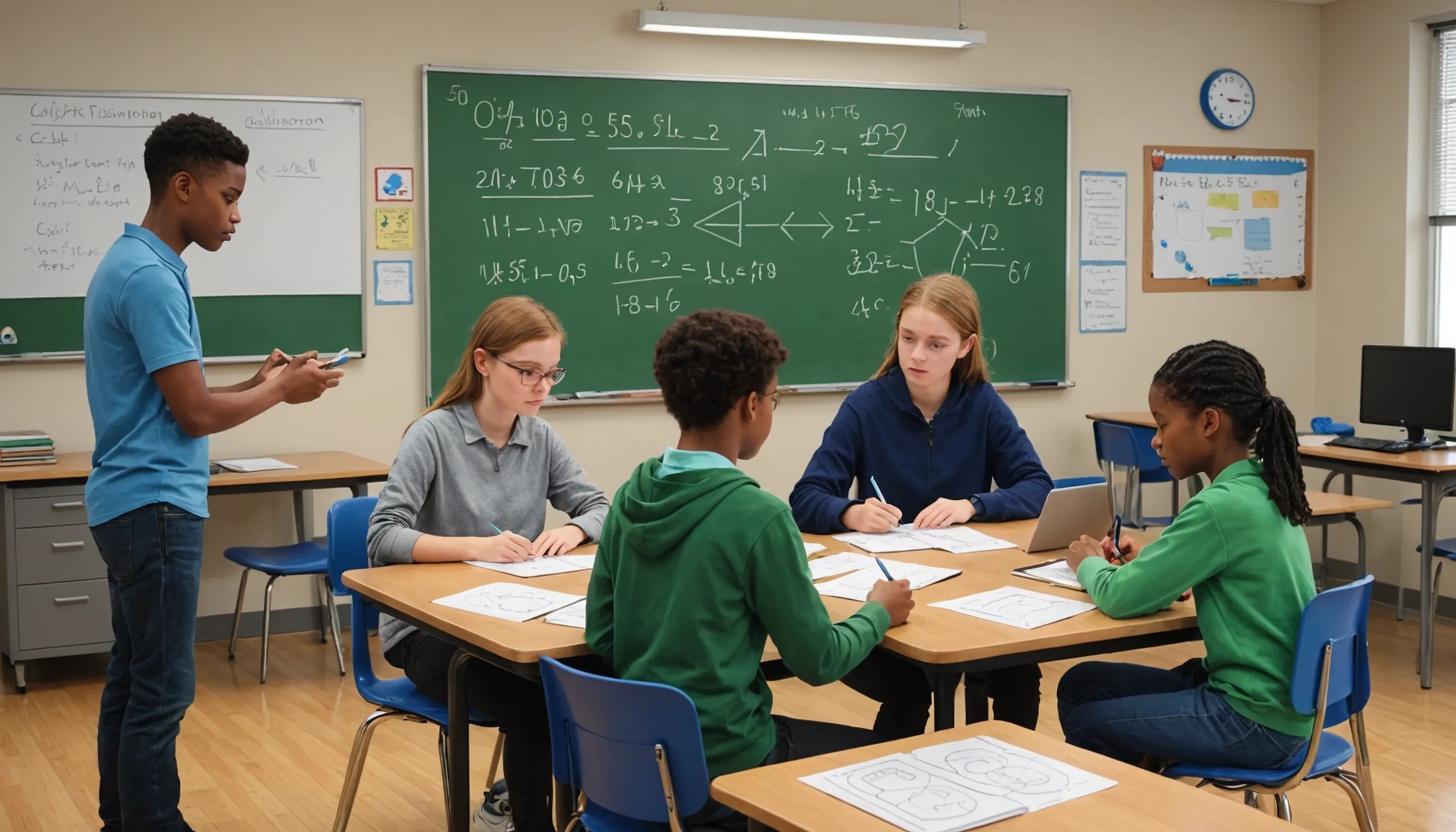Why is math learning fun for some but not for others?
 HvWHenry van Wagenberg
HvWHenry van Wagenberg
Understanding the Fun in Math Learning
Understanding why math learning can be fun for some students while feeling tedious for others involves exploring various factors. For many, the enjoyment stems from the sense of accomplishment that comes with solving complex problems. Engaging with math can stimulate curiosity and critical thinking, leading to a rewarding experience.
Additionally, when math is presented in a relatable context, students are more likely to find it enjoyable. The integration of games, real-world applications, and collaborative projects can transform math from a challenging subject into an exciting adventure. Thus, fostering a positive learning environment is key.
Factors That Make Math Enjoyable for Some
Several factors contribute to why math is enjoyable for some learners. One of the primary elements is the teaching approach. Instructors who use interactive methods, such as hands-on activities or technology, can make math more engaging. When students actively participate in their learning, they often find it more enjoyable.
Another factor is the relevance of math to everyday life. When students see how math applies to real-world situations, such as budgeting, cooking, or sports statistics, they can appreciate its value. This connection helps to demystify the subject and makes it feel less abstract.
Additionally, the learning environment plays a crucial role. A supportive atmosphere where students feel comfortable asking questions and making mistakes fosters enjoyment. Peer interaction can enhance this experience; working in groups allows students to share ideas and learn from one another, making the process more collaborative and fun.
Moreover, recognizing individual learning styles can impact enjoyment. Visual learners, for instance, may thrive on diagrams and graphs, while kinesthetic learners benefit from physical activities. Tailoring math instruction to meet these varying needs can significantly enhance engagement.
Lastly, an encouraging feedback system boosts confidence. Positive reinforcement from teachers and peers can motivate students to embrace challenges rather than shy away from them, further enhancing their enjoyment of math.
The Role of Teaching Methods in Math Enjoyment
The role of teaching methods in math enjoyment is crucial, as the way math is presented can significantly influence a student's perception of the subject. Traditional teaching methods, which often rely heavily on lectures and rote memorization, may lead to disengagement and a lack of interest in math. In contrast, innovative and interactive teaching strategies can transform the learning experience.
One effective approach is the use of project-based learning, where students work on real-world problems that require math to solve. This method not only increases engagement but also helps students see the practical applications of mathematical concepts. For instance, a project involving budgeting for a class event can make arithmetic more relatable and enjoyable.
Incorporating technology into math instruction is another way to enhance enjoyment. Tools such as educational apps, online games, and interactive software can make learning math more dynamic. These technologies provide instant feedback and allow students to work at their own pace, fostering a sense of autonomy and confidence.
Additionally, using collaborative learning techniques can create a supportive environment where students feel comfortable sharing ideas and discussing solutions. Group activities and peer tutoring not only make learning more fun but also build a sense of community.
Ultimately, when teaching methods are varied and adaptive to student needs, math becomes more enjoyable, fostering a lifelong appreciation for the subject.

Influence of Peer Interaction on Math Learning
The influence of peer interaction on math learning is profound and multifaceted. When students engage with one another during math activities, they experience a rich exchange of ideas and perspectives that can enhance their understanding of mathematical concepts. Collaborative learning environments promote discussion, allowing students to articulate their thought processes and confront misconceptions in a supportive setting.
Working in groups encourages students to tackle challenging problems together, fostering a sense of camaraderie and shared responsibility. This collaborative approach not only makes learning more enjoyable but also helps students develop critical thinking and problem-solving skills. According to research, students who participate in peer learning often outperform their peers who study independently, as they benefit from diverse strategies and insights.
Moreover, peer interaction can significantly reduce feelings of math anxiety. When students feel comfortable with their classmates, they are more likely to take risks and ask questions without fear of judgment. This supportive dynamic can lead to a more positive attitude towards math, making it less intimidating.
Additionally, peer mentoring can play a vital role in math learning. More advanced students can help their peers grasp challenging concepts, reinforcing their own understanding in the process. This reciprocal teaching not only benefits the learners but also cultivates leadership skills in the mentors.
In conclusion, peer interaction is a key factor in making math learning more effective and enjoyable, contributing significantly to students' academic success and emotional well-being.
Challenges That Make Math Less Fun for Others
Several challenges can make math less enjoyable for some learners. One significant factor is math anxiety, which can lead to stress and fear when faced with mathematical tasks. This anxiety often stems from previous negative experiences or high-pressure environments. Additionally, a lack of relevance in the material can cause disengagement; if students don’t see how math applies to their lives, they may find it tedious. Furthermore, teaching methods that rely solely on rote memorization can stifle creativity and interest, making the subject feel monotonous. Addressing these challenges is essential for fostering a more positive math learning experience.
Math Anxiety and Its Impact on Learning
Math anxiety is a prevalent issue that affects many students, leading to significant challenges in their learning process. This form of anxiety can manifest in various ways, impacting both emotional well-being and academic performance. Understanding its effects is crucial for educators and parents alike.
Here are some key points on how math anxiety influences learning:
- Fear of Failure: Students with math anxiety often fear making mistakes, which can hinder their willingness to participate in class or attempt challenging problems.
- Reduced Self-Esteem: Continuous struggles with math can lead to lower self-esteem and a negative self-image, reinforcing the belief that they are “bad” at math.
- Avoidance Behavior: To escape feelings of anxiety, students may avoid math-related activities altogether, leading to gaps in their knowledge and skills.
- Physical Symptoms: Math anxiety can cause physical reactions such as sweating, rapid heartbeat, or even nausea, making it difficult for students to concentrate.
Addressing math anxiety is essential to improve student outcomes. Here are some strategies that can help:
- Positive Reinforcement: Encourage students by celebrating their successes, no matter how small.
- Relaxation Techniques: Teach stress-reduction methods, such as deep breathing or mindfulness, to help students manage anxiety.
- Real-Life Applications: Demonstrating the relevance of math in everyday life can help students feel more connected to the subject.
By recognizing and addressing math anxiety, we can create a more supportive and effective learning environment.

The Importance of Relevance in Math Education
The importance of relevance in math education cannot be overstated, as it plays a crucial role in engaging students and enhancing their understanding of mathematical concepts. When students see how math applies to their daily lives, they are more likely to find joy and purpose in learning.
Here are some reasons why relevance matters in math education:
- Increased Engagement: When math lessons incorporate real-world problems, students become more interested and motivated to learn. For example, using budgeting scenarios can help students see the practical side of arithmetic.
- Improved Retention: Students are more likely to remember mathematical concepts that they can relate to. By connecting abstract ideas to tangible experiences, educators can enhance long-term retention.
- Development of Critical Thinking: Relevance encourages students to think critically and apply math skills to solve practical problems, fostering deeper understanding and analytical abilities.
- Boosted Confidence: When students successfully apply math to real-life situations, it builds their confidence and reinforces the idea that they can use math effectively.
To make math relevant, educators can:
- Incorporate Real-Life Examples: Use scenarios from students' lives, such as shopping, sports statistics, or cooking, to illustrate mathematical concepts.
- Engage in Project-Based Learning: Assign projects that require students to use math in a practical context, such as planning a community event or designing a product.
- Utilize Technology: Integrate tools like simulations and apps that connect math to real-world applications.
By emphasizing relevance, educators can create a more engaging and effective math learning experience for students.
Individual Learning Styles and Their Influence on Math
Individual learning styles significantly influence how students engage with and understand math. Recognizing these differences is crucial for tailoring instruction to meet diverse needs. Here are some common learning styles and their impact on math education:
- Visual Learners: These students benefit from diagrams, charts, and visual aids that illustrate mathematical concepts. Using graphical representations can enhance their comprehension.
- Auditory Learners: Students who learn best through listening thrive in environments where discussions, lectures, and verbal explanations are prevalent. Incorporating storytelling or verbal problem-solving can aid their understanding.
- Kinesthetic Learners: Hands-on activities and manipulatives are essential for these learners. Engaging in physical activities, like using blocks or interactive math games, helps them grasp abstract concepts.
By embracing different learning styles, educators can create a more inclusive math curriculum that fosters engagement and success for all students.
How Visual Learners Benefit from Math
Visual learners thrive in educational environments that utilize visual aids and graphical representations, making math a particularly rewarding subject for them. By incorporating images, diagrams, and charts into math lessons, educators can significantly enhance the learning experience for these students.
Here are some ways visual learners benefit from math:
- Enhanced Understanding: Visual aids help students grasp abstract concepts by turning them into concrete forms. For instance, using pie charts can simplify the understanding of fractions, while geometric shapes can clarify spatial relationships.
- Improved Memory Retention: Visual learners often remember information better when it is presented in a visual format. This can include color-coded notes or infographics that summarize key points, making it easier to recall information during tests.
- Increased Engagement: Interactive tools, such as graphing software or visual problem-solving apps, can capture the interest of visual learners and encourage active participation in math activities.
- Facilitation of Problem-Solving: Visual learners can break down complex problems into manageable parts by using diagrams or flowcharts, aiding their ability to analyze and solve mathematical challenges.
To support visual learners, educators should incorporate various visual tools, such as videos, charts, and interactive whiteboards, into their math curriculum. By doing so, they create a dynamic learning environment that caters to the strengths of visual learners, ultimately enhancing their success in mathematics.
Engaging Activities That Make Math Fun
Engaging activities can transform math from a daunting subject into a fun and enjoyable experience for students. By incorporating interactive and creative methods, educators can spark interest and enthusiasm in math learning. Here are some effective activities that make math fun:
- Math Games: Board games, card games, and online math games can provide a playful approach to learning. Games that involve strategy, such as "Math Bingo" or "Math Jeopardy," encourage friendly competition while reinforcing math concepts.
- Real-World Math Projects: Assigning projects that require students to apply math in real-life scenarios, such as budgeting for a class event or designing a product, allows them to see the relevance of math in everyday life.
- Interactive Math Stations: Setting up different stations with hands-on activities, puzzles, or technology can cater to various learning styles. This approach keeps students engaged and allows them to explore math concepts at their own pace.
- Math Art Integration: Combining math with art, such as creating geometric designs or exploring symmetry through drawing, makes learning visually appealing and enjoyable.
- Collaborative Group Work: Encouraging group projects where students work together to solve problems fosters teamwork and communication skills while making learning social and fun.
By implementing these engaging activities, educators can create a positive and dynamic math learning environment that motivates students and helps them develop a love for the subject.
